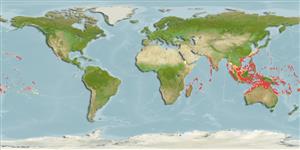Common names from other countries
Environment: milieu / climate zone / depth range / distribution range
Ecologia
marinhas; estuarina associadas(os) a recifes; intervalo de profundidade 1 - 80 m (Ref. 90102). Tropical; 35°N - 25°S
Pacific Ocean: northwest Australia, Moluccas, and Philippines to the Marquesan and Society islands, north to Ryukyu Islands, south to Rowley Shoals, Western Australia, and Tonga; Mariana and Caroline Islands in Micronesia.
Tamanho / Peso / Idade
Maturity: Lm ? range ? - ? cm
Max length : 13.6 cm TL macho/indeterminado; (Ref. 90102); common length : 10.4 cm SL macho/indeterminado; (Ref. 37816)
Espinhos dorsais (total) : 12; Raios dorsais (total) : 9; Espinhos anais: 3; Raios anais : 5. Submarginal black band on inner pectoral fin surface complete; eyes relatively large; snout relatively short; hump on back less obvious as in S. diabolus; SL to 10.4 cm. No black spot nearly as large as eye on inner surface of pectoral fins. A narrow triangular black mark inside mouth at front of upper jaw behind teeth. Ascending process of premaxilla broad, its maximum width 1.4-1.8 in orbit diameter. No series papillae or nodules across interorbital space between supraocular spines. Nasal spine single (Ref 42181).
A rare inhabitant of mixed sand and rubble areas of reef flats and shallow lagoons. Feeds on fishes (Ref. 89972). Usually buries itself in the substrate when in sand or sits amongst rubble where it has good camouflage (Ref. 48635). Anterolateral glandular grooves with venom gland (Ref. 57406). Solitary or in pairs (Ref 90102).
Ciclo de vida ou comportamento de acasalamento
Maturities | Reprodução | Spawnings | Egg(s) | Fecundities | Larvas
Myers, R.F., 1991. Micronesian reef fishes. Second Ed. Coral Graphics, Barrigada, Guam. 298 p. (Ref. 1602)
Status na Lista Vermelha da UICN (Ref. 130435)
CITES (Ref. 128078)
Not Evaluated
Uso pelos humanos
Ferramentas
Relatórios especiais
Baixar XML
Fontes da internet
Estimates based on models
Preferred temperature (Ref.
115969): 25 - 28.9, mean 27.7 (based on 672 cells).
Índice de diversidade filogenética (Ref.
82804): PD
50 = 0.5000 [Uniqueness, from 0.5 = low to 2.0 = high].
Bayesian length-weight: a=0.01259 (0.00606 - 0.02615), b=3.03 (2.86 - 3.20), in cm Total Length, based on LWR estimates for this (Sub)family-body shape (Ref.
93245).
Nível Trófico (Ref.
69278): 3.9 ±0.7 se; based on size and trophs of closest relatives
Resiliência (Ref.
120179): Elevada, tempo mínimo de duplicação da população menor que 15 meses (Preliminary K or Fecundity.).
Fishing Vulnerability (Ref.
59153): Low vulnerability (10 of 100).
